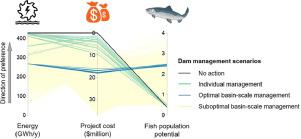Resources, Conservation and Recycling ( IF 11.2 ) Pub Date : 2020-06-20 , DOI: 10.1016/j.resconrec.2020.104990 Cuihong Song , Andrew O'Malley , Joseph Zydlewski , Weiwei Mo

|
Dam management often involves tradeoffs among hydropower generation capacity, environmental impacts, and project costs. However, our understandings of such tradeoffs under a full range of dam management options remain limited, which hinders our ability to make sound and scientifically defensible dam management decisions. In order to assess the scope for theoretical tradeoffs, a dynamic model of hydropower production, important fish populations, and project costs was developed using the system dynamics modeling technique. Three dam management options investigated the likely outcomes from: dam removal, fishway installation (e.g., pool-and-weir, Denil, and fish lift), and no action. The model was applied to the Penobscot River located in Maine, United States as a proof of concept, where recent actions (i.e., dam removal and fishway construction) have been undertaken. We modeled theoretical influence of these actions on four significant sea-run fish (alewife Alosa pseudoharengus, American shad Alosa sapidissima, Atlantic salmon Salmo salar, and sea lamprey Petromyzon marinus) by developing an index of spawner population potential based on population models for each species. Optimal dam management solutions may maximize spawner population potential and energy production to 60-62% of maximum achievable values while limiting the project cost to US$17 million (44% of the maximum value). Our results demonstrate that basin-scale management strategies may increase the migratory fish restoration while preserving hydropower generation capacity. Diversification of management options (e.g., combination of fishway installations, dam removals, and generation capacity) may increase the efficacy of strategic fish-energy-cost tradeoffs.
中文翻译:

通过战略性全流域大坝管理来平衡鱼-能量-成本的权衡
大坝管理通常需要在水力发电能力,环境影响和项目成本之间进行权衡。但是,我们对各种大坝管理方案下的权衡取舍的理解仍然有限,这阻碍了我们做出合理且科学上可行的大坝管理决策的能力。为了评估理论上的权衡范围,使用系统动力学建模技术开发了水力发电,重要鱼类种群和项目成本的动态模型。三种水坝管理方案调查了以下可能产生的结果:水坝拆除,鱼道安装(例如水池和围堰,丹尼尔和鱼举)以及没有采取任何行动。该模型已应用于美国缅因州的Penobscot河,以此作为概念验证,其中最近的行为(例如,大坝拆除和鱼道建设已经进行。我们模拟了这些行为对四种重要的海水鱼类(alewife)的理论影响拟南芥(Alosa pseudoharengus),美国d(Alosa sapidissima),大西洋鲑鱼(Salmo salar)和海鳗属Petromyzon marinus),然后根据每个物种的种群模型开发出产卵种群潜力指数。最佳的大坝管理解决方案可以将产卵种群的潜力和能源生产最大化,达到最大可实现价值的60-62%,同时将项目成本限制在1,700万美元(最大价值的44%)。我们的结果表明,流域规模的管理策略可以在保持水力发电能力的同时,增加鱼类的迁徙。管理选择的多样化(例如,鱼道设施,大坝拆除和发电能力的组合)可能会提高战略性鱼类-能源-成本权衡的有效性。











































 京公网安备 11010802027423号
京公网安备 11010802027423号